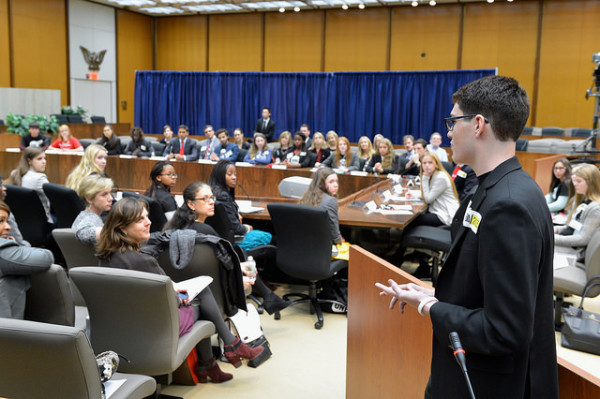Premed Perspective From Switzerland: Part VI
In March, I had the opportunity to sit in on a panel organized by the United Nations Development Program (UNDP) and the Swiss Development Coordination (SDC) on the new Sustainable Development Goals (SDGs), which will be replacing the Millennium Development Goals (MDGs). I felt that the subsequent discussion was relevant to anyone interested in public health, international development, or global policy.
Image Source: Anadolu Agency
A quick overview of the sustainable development goals and the millennium development goals:
The millennium development goals, or MDGs, are eight international development goals that were established in 2000 and range from halting the spread of HIV/AIDS to providing universal primary education, all by 2015. The sustainable development goals, or SDGs, are the proposed new group of goals that will replace the MDGs once they expire in 2015. There are currently 17 proposed goals that cover a broad range of sustainable development issues, including combating climate change and halting the spread of non-communicable diseases, like cancer and diabetes.
The panel was titled, “From Vision to Implementation: How can we make the SDG’s a reality?” and featured the following panelists:
– Magdy Martínez-Solimán (Assistant Secretary General, UNDP Director of the Bureau for Policy and Programme Support)
– Michael Gerber (Ambassador and Special Envoy for Global Sustainable Development)
– Gilles Carbonnier (Professor of Development Economics, Graduate Institute)
I’ve included a few interesting questions from the panel and discussion below:
1. Who are the key players in developing the SDGs?
Despite the prominence of other players in the global sphere, ultimately governments are the ones that will be held accountable for negotiating, implementing, coordinating, and working with others to implement the SDGs. While the WHO will naturally play a prominent role, there is only so much it can do, being a member-state organization. This situation mirrors the environment of the MDGs. However, the difference between the environment in which the MDGs were established and the environment in which the SDGs are being established is that the private sector will also play a huge role this time around. According to Mr. Gerber, today the private sector is actually becoming more important than traditional areas like oversees development assistance (ODA). ODA is a flow of money provided by official agencies – like governments – administered for “the purpose of economic development and the welfare of developing countries”, and it was the traditional model for development aid.
2. Can the traditional structures of development aid be changed, and should the development sector reform itself?
One of the biggest changes that the speakers championed is the merging normative and the action-oriented work. Currently, the development sector is divided between normative agencies like the UN and WHO, which set norms and standards, and action-oriented agencies like the MSF. While this is useful in that it breaks apart the work into digestible chunks based on various organizations’ strengths, it has also led to the WHO working in complicated silos that reduce efficiency. There also isn’t enough dialogue between normative agencies like the WHO and action-oriented agencies. For example, in my internship, I discovered that there is a disconnect between the pharmaceutical industries that develop HIV/AIDS drugs, the WHO that writes the guidelines, and the in-country regulators of drugs. That is why partnerships between these groups, often mediated by outside organizations, such as the International AIDS Society in this case, allow these actors to reach a consensus and make public health work much more efficient.
The other mindset shift that the speakers advocated is a gradual decrease the “North-South divide“, which describes the socioeconomic and political divide between roughly the northern and southern halves of the hemisphere. The North is home to four-fifths of the permanent members of the UN Security Council, and mostly covers the West and First World. On the other hand, the South is considered to be the poorer, less developed region, and it has access to one-fifth the world’s income. Traditionally in the world of development aid, there was a flow of cash from the North to the South, something that is particularly apparent in the MDGs. However, the SDGs apply to both the North and the South, as many of them include things like non-communicable diseases and poverty. Thus, there should be a totally different approach for the SDGs.
3. How can we put in mechanisms that build the needed trust and accountability between multilateral organizations, governments, and the private sector?
Transparency was of key importance to all of the speakers, as well as establishment of better indicators besides GDP to measure a country’s economic performance. For example, it turns out that looking at satellite imaging of sub-Saharan Africa at night is a better proxy for looking at economic growth than GDP! GDP measurements are skewed in developing countries because the fraction of economic activity conducted within the formal sector is much smaller compared to developed countries. At the same time, research has found that the brightness of visible lights is strongly related to both population density and income per capita.
Another issue that the speakers brought up is the politicization of the SDGs. For example, SDG #16, (“promote peaceful and inclusive societies for sustainable development, provide access to justice for all and build effective, accountable, and institutions at all levels”) is seen by many countries as a threat to national sovereignty because it has the feel of “measuring governance”. It will be crucial to address this in order to build trust between governments and the larger development community.
Despite the challenges enumerated by the panel above, overall there was a general sense of optimism in the room about the establishment of the SDGs. While the SDGs do appear to be more idealistic than the MDGs, this is still the beginning of the year. Hopefully by the end of this year when the SDGs are finalized, they will be more concrete and actionable.
Feature Image Source: U.S. Department of State
< Part V: The Business of HIV Drugs
Part VII: When Two Human Rights Fight: An Overlooked Challenge in Migration & Health >










